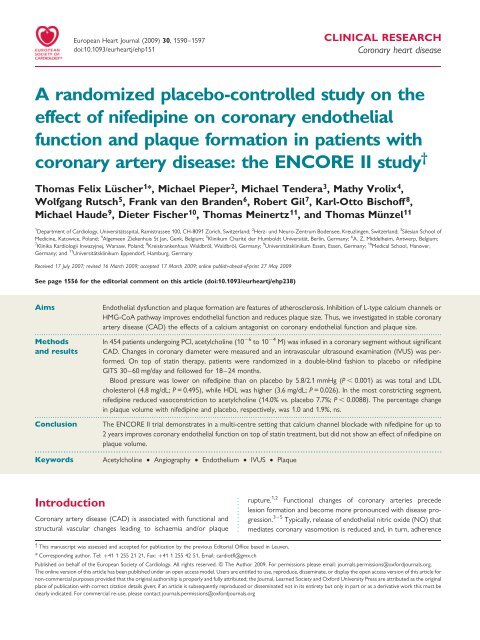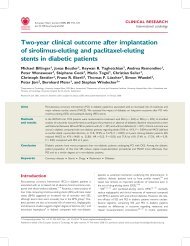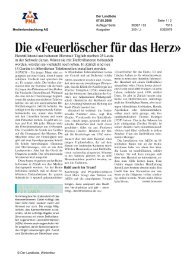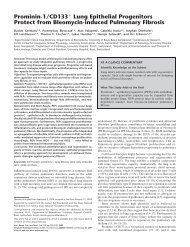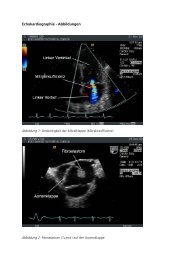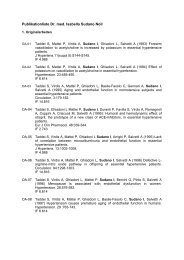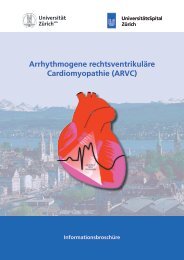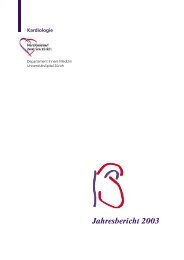A randomized placebo-controlled study on the effect of nifedipine on ...
A randomized placebo-controlled study on the effect of nifedipine on ...
A randomized placebo-controlled study on the effect of nifedipine on ...
Create successful ePaper yourself
Turn your PDF publications into a flip-book with our unique Google optimized e-Paper software.
European Heart Journal (2009) 30, 1590–1597<br />
doi:10.1093/eurheartj/ehp151<br />
CLINICAL RESEARCH<br />
Cor<strong>on</strong>ary heart disease<br />
A <str<strong>on</strong>g>randomized</str<strong>on</strong>g> <str<strong>on</strong>g>placebo</str<strong>on</strong>g>-<str<strong>on</strong>g>c<strong>on</strong>trolled</str<strong>on</strong>g> <str<strong>on</strong>g>study</str<strong>on</strong>g> <strong>on</strong> <strong>the</strong><br />
<strong>effect</strong> <strong>of</strong> <strong>nifedipine</strong> <strong>on</strong> cor<strong>on</strong>ary endo<strong>the</strong>lial<br />
functi<strong>on</strong> and plaque formati<strong>on</strong> in patients with<br />
cor<strong>on</strong>ary artery disease: <strong>the</strong> ENCORE II <str<strong>on</strong>g>study</str<strong>on</strong>g> †<br />
Thomas Felix Lüscher 1 *, Michael Pieper 2 , Michael Tendera 3 , Mathy Vrolix 4 ,<br />
Wolfgang Rutsch 5 , Frank van den Branden 6 , Robert Gil 7 , Karl-Otto Bisch<strong>of</strong>f 8 ,<br />
Michael Haude 9 , Dieter Fischer 10 , Thomas Meinertz 11 , and Thomas Münzel 11<br />
1 Department <strong>of</strong> Cardiology, Universitätsspital, Ramistrassee 100, CH-8091 Zürich, Switzerland; 2 Herz- und Neuro-Zentrum Bodensee, Kreuzlingen, Switzerland; 3 Silesian School <strong>of</strong><br />
Medicine, Katowice, Poland; 4 Algemeen Ziekenhuis St Jan, Genk, Belgium; 5 Klinikum Charité der Humboldt Universität, Berlin, Germany; 6 A. Z. Middelheim, Antwerp, Belgium;<br />
7 Klinika Kardiologii Inwazyjnej, Warsaw, Poland; 8 Kreiskrankenhaus Waldbröl, Waldbröl, Germany; 9 Universitätsklinikum Essen, Essen, Germany; 10 Medical School, Hanover,<br />
Germany; and 11 Universitätsklinikum Eppendorf, Hamburg, Germany<br />
Received 17 July 2007; revised 16 March 2009; accepted 17 March 2009; <strong>on</strong>line publish-ahead-<strong>of</strong>-print 27 May 2009<br />
See page 1556 for <strong>the</strong> editorial comment <strong>on</strong> this article (doi:10.1093/eurheartj/ehp238)<br />
Aims<br />
Endo<strong>the</strong>lial dysfuncti<strong>on</strong> and plaque formati<strong>on</strong> are features <strong>of</strong> a<strong>the</strong>rosclerosis. Inhibiti<strong>on</strong> <strong>of</strong> L-type calcium channels or<br />
HMG-CoA pathway improves endo<strong>the</strong>lial functi<strong>on</strong> and reduces plaque size. Thus, we investigated in stable cor<strong>on</strong>ary<br />
artery disease (CAD) <strong>the</strong> <strong>effect</strong>s <strong>of</strong> a calcium antag<strong>on</strong>ist <strong>on</strong> cor<strong>on</strong>ary endo<strong>the</strong>lial functi<strong>on</strong> and plaque size.<br />
.....................................................................................................................................................................................<br />
Methods In 454 patients undergoing PCI, acetylcholine (10 26 to 10 24 M) was infused in a cor<strong>on</strong>ary segment without significant<br />
and results CAD. Changes in cor<strong>on</strong>ary diameter were measured and an intravascular ultrasound examinati<strong>on</strong> (IVUS) was performed.<br />
On top <strong>of</strong> statin <strong>the</strong>rapy, patients were <str<strong>on</strong>g>randomized</str<strong>on</strong>g> in a double-blind fashi<strong>on</strong> to <str<strong>on</strong>g>placebo</str<strong>on</strong>g> or <strong>nifedipine</strong><br />
GITS 30–60 mg/day and followed for 18–24 m<strong>on</strong>ths.<br />
Blood pressure was lower <strong>on</strong> <strong>nifedipine</strong> than <strong>on</strong> <str<strong>on</strong>g>placebo</str<strong>on</strong>g> by 5.8/2.1 mmHg (P , 0.001) as was total and LDL<br />
cholesterol (4.8 mg/dL; P = 0.495), while HDL was higher (3.6 mg/dL; P = 0.026). In <strong>the</strong> most c<strong>on</strong>stricting segment,<br />
<strong>nifedipine</strong> reduced vasoc<strong>on</strong>stricti<strong>on</strong> to acetylcholine (14.0% vs. <str<strong>on</strong>g>placebo</str<strong>on</strong>g> 7.7%; P , 0.0088). The percentage change<br />
in plaque volume with <strong>nifedipine</strong> and <str<strong>on</strong>g>placebo</str<strong>on</strong>g>, respectively, was 1.0 and 1.9%, ns.<br />
.....................................................................................................................................................................................<br />
C<strong>on</strong>clusi<strong>on</strong><br />
The ENCORE II trial dem<strong>on</strong>strates in a multi-centre setting that calcium channel blockade with <strong>nifedipine</strong> for up to<br />
2 years improves cor<strong>on</strong>ary endo<strong>the</strong>lial functi<strong>on</strong> <strong>on</strong> top <strong>of</strong> statin treatment, but did not show an <strong>effect</strong> <strong>of</strong> <strong>nifedipine</strong> <strong>on</strong><br />
plaque volume.<br />
-----------------------------------------------------------------------------------------------------------------------------------------------------------<br />
Keywords Acetylcholine † Angiography † Endo<strong>the</strong>lium † IVUS † Plaque<br />
Introducti<strong>on</strong><br />
Cor<strong>on</strong>ary artery disease (CAD) is associated with functi<strong>on</strong>al and<br />
structural vascular changes leading to ischaemia and/or plaque<br />
rupture. 1,2 Functi<strong>on</strong>al changes <strong>of</strong> cor<strong>on</strong>ary arteries precede<br />
lesi<strong>on</strong> formati<strong>on</strong> and become more pr<strong>on</strong>ounced with disease progressi<strong>on</strong>.<br />
3–5 Typically, release <strong>of</strong> endo<strong>the</strong>lial nitric oxide (NO) that<br />
mediates cor<strong>on</strong>ary vasomoti<strong>on</strong> is reduced and, in turn, adherence<br />
† This manuscript was assessed and accepted for publicati<strong>on</strong> by <strong>the</strong> previous Editorial Office based in Leuven.<br />
* Corresp<strong>on</strong>ding author. Tel: þ41 1 255 21 21, Fax: þ41 1 255 42 51, Email: cardiotfl@gmx.ch<br />
Published <strong>on</strong> behalf <strong>of</strong> <strong>the</strong> European Society <strong>of</strong> Cardiology. All rights reserved. & The Author 2009. For permissi<strong>on</strong>s please email: journals.permissi<strong>on</strong>s@oxfordjournals.org.<br />
The <strong>on</strong>line versi<strong>on</strong> <strong>of</strong> this article has been published under an open access model. Users are entitled to use, reproduce, disseminate, or display <strong>the</strong> open access versi<strong>on</strong> <strong>of</strong> this article for<br />
n<strong>on</strong>-commercial purposes provided that <strong>the</strong> original authorship is properly and fully attributed; <strong>the</strong> Journal, Learned Society and Oxford University Press are attributed as <strong>the</strong> original<br />
place <strong>of</strong> publicati<strong>on</strong> with correct citati<strong>on</strong> details given; if an article is subsequently reproduced or disseminated not in its entirety but <strong>on</strong>ly in part or as a derivative work this must be<br />
clearly indicated. For commercial re-use, please c<strong>on</strong>tact journals.permissi<strong>on</strong>s@oxfordjournals.org
Endo<strong>the</strong>lial functi<strong>on</strong> and plaques in CAD 1591<br />
<strong>of</strong> m<strong>on</strong>ocytes and platelets and subsequently smooth muscle<br />
cell migrati<strong>on</strong> and proliferati<strong>on</strong> are increased. 2,3 Endo<strong>the</strong>lial dysfuncti<strong>on</strong><br />
occurs as a ‘resp<strong>on</strong>se to injury’ to oxidized low-density<br />
lipoproteins, 2,6 hypertensi<strong>on</strong>, 7–9 increased blood glucose, 10,11<br />
and oxygen-derived free radicals. 12<br />
Treatment modalities able to reverse endo<strong>the</strong>lial dysfuncti<strong>on</strong><br />
might have great clinical implicati<strong>on</strong>s. Several targets have been c<strong>on</strong>sidered,<br />
am<strong>on</strong>g <strong>the</strong>m <strong>the</strong> renin–angiotensin system that inactivates<br />
NO via stimulati<strong>on</strong> <strong>of</strong> NADPH-oxidase and thus <strong>the</strong> producti<strong>on</strong> <strong>of</strong><br />
superoxide. 13 ACE-inhibitors improve endo<strong>the</strong>lial functi<strong>on</strong> in <strong>the</strong><br />
brachial 14 and <strong>the</strong> cor<strong>on</strong>ary circulati<strong>on</strong>. 15,16 Inhibiti<strong>on</strong> <strong>of</strong> HMGcoenzyme<br />
reductase not <strong>on</strong>ly reduces cholesterol, but also leads<br />
to prenylati<strong>on</strong> and geranylati<strong>on</strong> <strong>of</strong> proteins involved in <strong>the</strong> regulati<strong>on</strong><br />
<strong>of</strong> nitric oxide. 17 In <strong>the</strong> forearm, circulati<strong>on</strong> statins improve endo<strong>the</strong>lial<br />
functi<strong>on</strong> in hypercholesterolaemia. 18 In <strong>the</strong> cor<strong>on</strong>ary circulati<strong>on</strong>,<br />
<strong>the</strong> <strong>effect</strong>s <strong>of</strong> statins are c<strong>on</strong>troversial at least after 6 m<strong>on</strong>ths<br />
<strong>of</strong> treatment 16,19 suggesting that in patients with stable CAD more<br />
time may be required to improve NO-mediated vasomoti<strong>on</strong>.<br />
Calcium channel blockers may reduce oxidative stress and<br />
improve NO release independent <strong>of</strong> <strong>the</strong>ir <strong>effect</strong>s <strong>on</strong> L-type<br />
calcium channels. 20,21 In previous studies, <strong>nifedipine</strong> improved<br />
endo<strong>the</strong>lial functi<strong>on</strong> after 6 m<strong>on</strong>ths; 16 however, <strong>the</strong> impact <strong>on</strong><br />
a<strong>the</strong>rosclerotic plaque formati<strong>on</strong> is uncertain.<br />
We, <strong>the</strong>refore, investigated in patients with stable CAD undergoing<br />
a percutaneous interventi<strong>on</strong> (PCI) <strong>the</strong> <strong>effect</strong>s <strong>of</strong> l<strong>on</strong>g-acting<br />
<strong>nifedipine</strong> <strong>on</strong> cor<strong>on</strong>ary endo<strong>the</strong>lial functi<strong>on</strong> and plaque formati<strong>on</strong><br />
over 18–24 m<strong>on</strong>ths <strong>on</strong> top <strong>of</strong> standard <strong>the</strong>rapy, including a statin. 22<br />
Methods<br />
Patients<br />
The ENCORE II (Evaluati<strong>on</strong> <strong>of</strong> Nifedipine <strong>on</strong> Cor<strong>on</strong>ary Endo<strong>the</strong>lial<br />
Functi<strong>on</strong>) Study was a <str<strong>on</strong>g>randomized</str<strong>on</strong>g>, double-blind, <str<strong>on</strong>g>placebo</str<strong>on</strong>g>-<str<strong>on</strong>g>c<strong>on</strong>trolled</str<strong>on</strong>g><br />
<str<strong>on</strong>g>study</str<strong>on</strong>g> investigating <strong>the</strong> <strong>effect</strong> <strong>of</strong> <strong>nifedipine</strong> GITS 30 mg/day increased<br />
to 60 mg/day <strong>on</strong> endo<strong>the</strong>lial vasomoti<strong>on</strong> and a<strong>the</strong>rosclerotic burden<br />
in patients undergoing cor<strong>on</strong>ary angiography with or without PCI.<br />
Inclusi<strong>on</strong> criteria were: legal age, left cor<strong>on</strong>ary artery segment with<br />
40% area stenosis (index artery), and no vasodilati<strong>on</strong> <strong>of</strong> index artery<br />
up<strong>on</strong> acetylcholine infusi<strong>on</strong>. Patients with at least <strong>on</strong>e segment <strong>of</strong> <strong>the</strong><br />
index artery without vasodilati<strong>on</strong> <strong>on</strong> acetylcholine (visual inspecti<strong>on</strong>)<br />
were eligible. Main exclusi<strong>on</strong> criteria were: myocardial infarcti<strong>on</strong> (MI)<br />
within 2 weeks or unstable angina (Braunwald class IIIb trop<strong>on</strong>in positive),<br />
stroke, peripheral revascularizati<strong>on</strong> or major surgery within 3<br />
m<strong>on</strong>ths, un<str<strong>on</strong>g>c<strong>on</strong>trolled</str<strong>on</strong>g> diabetes, symptomatic hypotensi<strong>on</strong> or un<str<strong>on</strong>g>c<strong>on</strong>trolled</str<strong>on</strong>g><br />
hypertensi<strong>on</strong>, left ventricular ejecti<strong>on</strong> fracti<strong>on</strong> ,40%, creatinine<br />
.200 mmol/L, transaminases greater than three times ULN, history <strong>of</strong><br />
liver or gastrointestinal diseases, and calcium channel blocker treatment<br />
for .2 m<strong>on</strong>ths prior to inclusi<strong>on</strong>. ACE-inhibitors or ARBs used .2<br />
m<strong>on</strong>ths were c<strong>on</strong>tinued, o<strong>the</strong>rwise <strong>the</strong>y were not allowed. Participating<br />
sites had approval for <strong>the</strong> <str<strong>on</strong>g>study</str<strong>on</strong>g> from <strong>the</strong>ir Instituti<strong>on</strong>al Review Board or<br />
Ethics Committee and patients provided written informed c<strong>on</strong>sent.<br />
The first patient entered <strong>the</strong> <str<strong>on</strong>g>study</str<strong>on</strong>g> in June 1999 and last patient’s last<br />
visit took place in January 2004.<br />
Interventi<strong>on</strong>s<br />
Before interventi<strong>on</strong>, cardiovascular drugs were withheld for 24 h<br />
(short acting nitrates for at least 3 h). After cor<strong>on</strong>ary angiography<br />
and/or PCI, an infusi<strong>on</strong> ca<strong>the</strong>ter was positi<strong>on</strong>ed in a proximal<br />
segment <strong>of</strong> <strong>the</strong> left anterior descending or circumflex cor<strong>on</strong>ary<br />
artery with luminal narrowing ,40%. Acetylcholine (Miochol, Ciba<br />
Visi<strong>on</strong>, Basel, Switzerland) was infused at 2 mL/min for 3 min in <strong>the</strong> following<br />
order: (1–3) acetylcholine 0.36, 3.6, and 18 mg/ml; (4) isot<strong>on</strong>ic<br />
saline; and finally (5) a bolus <strong>of</strong> 250 mg nitroglycerine was injected. At<br />
<strong>the</strong> end <strong>of</strong> each infusi<strong>on</strong>, heart rate and blood pressure were recorded<br />
and angiography performed with n<strong>on</strong>-i<strong>on</strong>ic c<strong>on</strong>trast medium. Finally, an<br />
IVUS examinati<strong>on</strong> was made.<br />
Planned treatment durati<strong>on</strong> was 18–24 m<strong>on</strong>ths. At <strong>the</strong> end <strong>of</strong> <strong>the</strong><br />
treatment, patients underwent ca<strong>the</strong>terizati<strong>on</strong> after withdrawal <strong>of</strong><br />
<str<strong>on</strong>g>study</str<strong>on</strong>g> medicati<strong>on</strong> for 2–3 days and o<strong>the</strong>r cardiovascular drugs for<br />
24 h as at <strong>the</strong> baseline <str<strong>on</strong>g>study</str<strong>on</strong>g>. The X-ray tube and ca<strong>the</strong>ter were<br />
placed in identical positi<strong>on</strong>s and <strong>the</strong> IVUS ca<strong>the</strong>ter was placed at <strong>the</strong><br />
same anatomical landmarks as at baseline. The protocol was <strong>the</strong>n<br />
repeated in <strong>the</strong> index artery.<br />
Patients were seen in <strong>the</strong> clinic after 2 weeks, 1, 6, 12, and 18<br />
m<strong>on</strong>ths. Ambulatory blood pressures were taken with a sphygmomanometer.<br />
Clinical chemistry and haematology were analysed centrally<br />
(Institute for Clinical Chemistry, University Hospital <strong>of</strong> Freiburg,<br />
Germany). Cholesterol was determined enzymatically (CHOD-PAP<br />
method, Roche Diagnostics, Mannheim, Germany). HDL-cholesterol<br />
was determined with a homogenous HDL-C assay (Roche Diagnostics,<br />
Mannheim, Germany), and LDL-cholesterol was calculated using <strong>the</strong><br />
Friedewald formula.<br />
Study outcomes<br />
The primary endpoint was <strong>the</strong> <strong>effect</strong> <strong>of</strong> <strong>nifedipine</strong> compared with<br />
<str<strong>on</strong>g>placebo</str<strong>on</strong>g> <strong>on</strong> acetylcholine-induced cor<strong>on</strong>ary vascular resp<strong>on</strong>se at <strong>the</strong><br />
highest dose <strong>of</strong> acetylcholine applied both at baseline and follow-up.<br />
The sec<strong>on</strong>dary endpoint was <strong>the</strong> <strong>effect</strong> <strong>of</strong> <strong>nifedipine</strong> compared with<br />
<str<strong>on</strong>g>placebo</str<strong>on</strong>g> <strong>on</strong> <strong>the</strong> percentage change in plaque volume as assessed by<br />
intravascular ultrasound.<br />
Treatments and randomizati<strong>on</strong><br />
The protocol was designed as a <str<strong>on</strong>g>randomized</str<strong>on</strong>g>, double-blind, double<br />
dummy <str<strong>on</strong>g>study</str<strong>on</strong>g> with three treatment arms: cerivastatin 0.2 mg/day, cerivastatin<br />
0.8 mg/day, or cerivastatin 0.8 mg/day plus <strong>nifedipine</strong> GITS<br />
30–60 mg/day. 22 After 294 patients had been <str<strong>on</strong>g>randomized</str<strong>on</strong>g>, cerivastatin<br />
was withdrawn from <strong>the</strong> market due to untoward <strong>effect</strong>s. 23,24 The<br />
<str<strong>on</strong>g>study</str<strong>on</strong>g> was <strong>the</strong>refore modified to c<strong>on</strong>tinue to investigate <strong>the</strong> <strong>effect</strong>s<br />
<strong>of</strong> <strong>nifedipine</strong> GITS 30–60 mg/day vs. <str<strong>on</strong>g>placebo</str<strong>on</strong>g> <strong>on</strong> top <strong>of</strong> lipid lowering<br />
<strong>the</strong>rapy with a statin according to current guidelines. 25,26 Thus, patients<br />
<str<strong>on</strong>g>randomized</str<strong>on</strong>g> before withdrawal <strong>of</strong> cerivastatin who gave informed<br />
c<strong>on</strong>sent to c<strong>on</strong>tinue <strong>the</strong>ir participati<strong>on</strong> were c<strong>on</strong>tinued in <strong>the</strong>ir previous<br />
treatment arm minus cerivastatin—resulting in a 2:1 distributi<strong>on</strong><br />
<strong>of</strong> <strong>the</strong> patients <strong>on</strong> <str<strong>on</strong>g>placebo</str<strong>on</strong>g> and <strong>nifedipine</strong>, respectively. New patients<br />
were <strong>the</strong>refore <str<strong>on</strong>g>randomized</str<strong>on</strong>g> to <str<strong>on</strong>g>placebo</str<strong>on</strong>g> or <strong>nifedipine</strong> <strong>on</strong> a 1:2 ratio<br />
in order to get balanced samples in <strong>the</strong> two treatment arms. One<br />
hundred and twenty-three <strong>of</strong> <strong>the</strong> originally enrolled patients (42% <strong>of</strong><br />
<str<strong>on</strong>g>randomized</str<strong>on</strong>g> patients) re-entered <strong>the</strong> <str<strong>on</strong>g>study</str<strong>on</strong>g>. Ano<strong>the</strong>r 149 patients<br />
were <str<strong>on</strong>g>randomized</str<strong>on</strong>g> after restart leading to an evaluable populati<strong>on</strong> <strong>of</strong><br />
226 patients. The exposure time to <strong>nifedipine</strong> averaged 622 days<br />
(SD: +82 days; range: 488–853 days).<br />
A pre-prepared randomizati<strong>on</strong> list for each centre was generated by<br />
sp<strong>on</strong>sor’s statistician with block size 6 and no stratificati<strong>on</strong>s. Patients<br />
were assigned to next free medicati<strong>on</strong> box for <strong>the</strong>ir random allocati<strong>on</strong><br />
to treatment group.<br />
The randomizati<strong>on</strong> list was adapted for <strong>the</strong> re-design <strong>of</strong> <strong>the</strong> <str<strong>on</strong>g>study</str<strong>on</strong>g>.<br />
Patients <str<strong>on</strong>g>randomized</str<strong>on</strong>g> into <strong>the</strong> original <str<strong>on</strong>g>study</str<strong>on</strong>g> and who wanted to c<strong>on</strong>tinue<br />
kept <strong>the</strong>ir allocati<strong>on</strong> number without breaking <strong>the</strong> randomizati<strong>on</strong><br />
code.
1592<br />
T.F. Lüscher et al.<br />
Assessment <strong>of</strong> cor<strong>on</strong>ary artery diameter<br />
Angiograms were analysed at a core lab (Cardiology, Medical School,<br />
Hannover, Germany). Readers were blinded to patients’ identity and<br />
to treatment arm. In <strong>the</strong> index artery 2–7 (mean 3) segments distal to<br />
<strong>the</strong> infusi<strong>on</strong> ca<strong>the</strong>ter were measured using CMS edge-detecti<strong>on</strong> algorithm<br />
(MEDIS, Leiden, The Ne<strong>the</strong>rlands 27 ). Each segment was identified<br />
by anatomical landmarks according to AHA guidelines to facilitate identificati<strong>on</strong><br />
at follow-up. Mean diameters were measured at baseline and<br />
after each acetylcholine and nitroglycerine infusi<strong>on</strong>. Cor<strong>on</strong>ary resp<strong>on</strong>ses<br />
were expressed as percent change from baseline <strong>of</strong> <strong>the</strong><br />
acetylcholine-induced change in mean lumen diameter. The pre-defined<br />
target segment for <strong>the</strong> main comparis<strong>on</strong> was <strong>the</strong> <strong>on</strong>e with <strong>the</strong> most pr<strong>on</strong>ounced<br />
vasoc<strong>on</strong>stricti<strong>on</strong> at any acetylcholine dose at baseline.<br />
IVUS imaging procedure<br />
The IVUS <str<strong>on</strong>g>study</str<strong>on</strong>g> was performed after acetylcholine infusi<strong>on</strong>s. Intracor<strong>on</strong>ary<br />
nitroglycerine (0.1–0.2 mg) was given and <strong>the</strong> IVUS ca<strong>the</strong>ter<br />
positi<strong>on</strong>ed in <strong>the</strong> target vessel. Two different IVUS systems were<br />
used: 2.9 F 30 MHz Ultra Cross, Scimed, Bost<strong>on</strong> Scientific, Sunnyvale,<br />
CA, USA or a 2.9 F 30 MHz Visi<strong>on</strong> Five-64 F/X Endos<strong>on</strong>ics, Rancho<br />
Cordova, CA, USA. In each patient, <strong>the</strong> same ca<strong>the</strong>ter type was<br />
used at baseline and follow-up. The positi<strong>on</strong> <strong>of</strong> <strong>the</strong> IVUS ca<strong>the</strong>ter<br />
was <str<strong>on</strong>g>c<strong>on</strong>trolled</str<strong>on</strong>g> with fluoroscopy. The imaging transducer <strong>of</strong> <strong>the</strong><br />
IVUS ca<strong>the</strong>ter was placed distal to a major side branch <strong>of</strong> <strong>the</strong> target<br />
vessel and <strong>the</strong> positi<strong>on</strong> was documented. Anatomic orientati<strong>on</strong> was<br />
also guided by spoken comments during <strong>the</strong> IVUS <str<strong>on</strong>g>study</str<strong>on</strong>g>. IVUS pullback<br />
was mechanically d<strong>on</strong>e at 0.5 mm/s. Images, electrocardiogram, and<br />
comments during <strong>the</strong> pullback were recorded <strong>on</strong> S-VHS videotape.<br />
At follow-up, IVUS examinati<strong>on</strong>s were repeated to accurately match<br />
<strong>the</strong> cor<strong>on</strong>ary segment recorded at baseline.<br />
Analysis <strong>of</strong> IVUS images<br />
The tapes were analysed by <strong>the</strong> core laboratory (D.F.) at Hannover<br />
Medical School, Hannover, Germany according to <strong>the</strong> clinical<br />
expert c<strong>on</strong>sensus documentati<strong>on</strong> standards for <strong>the</strong> acquisiti<strong>on</strong>,<br />
measurement, and reporting <strong>of</strong> IVUS <strong>of</strong> <strong>the</strong> American College <strong>of</strong><br />
Cardiology. 28 Experienced investigators blinded to patients’ identity<br />
and treatment allocati<strong>on</strong> reviewed baseline and follow-up images.<br />
Calibrati<strong>on</strong> was performed with grid marks encoded in <strong>the</strong><br />
images. One image per sec<strong>on</strong>d was analysed. Using computerized<br />
planimetry (TapeMeasure, Indec Inc., Mountain View, CA, USA),<br />
borders <strong>of</strong> <strong>the</strong> vessel lumen and <strong>of</strong> <strong>the</strong> external elastic membrane<br />
(EEM) were identified and cross-secti<strong>on</strong>al area (CSA) measured.<br />
A<strong>the</strong>roma CSA was calculated by EEM CSA minus lumen CSA<br />
for each image. Total a<strong>the</strong>roma volume was computed as <strong>the</strong><br />
Table 1 Enrolment and flow <strong>of</strong> patients in <strong>the</strong> ENCORE II <str<strong>on</strong>g>study</str<strong>on</strong>g>
Endo<strong>the</strong>lial functi<strong>on</strong> and plaques in CAD 1593<br />
average a<strong>the</strong>roma CSA from all analysed slices <strong>of</strong> <strong>the</strong> segment multiplied<br />
by segment length. From this, total lumen volume and total<br />
EEM volume were derived. The sec<strong>on</strong>dary efficacy parameter,<br />
percent change in a<strong>the</strong>roma volume after 18–24 m<strong>on</strong>ths <strong>of</strong> treatment,<br />
was defined as:<br />
%Change VolA<strong>the</strong>roma ¼ 100 ðVol A<strong>the</strong>roma;Follow Up Vol A<strong>the</strong>roma;Baseline Þ<br />
Vol A<strong>the</strong>roma;Baseline<br />
:<br />
Statistical analysis<br />
All patients with a readable baseline and follow-up acetylcholine and/<br />
or IVUS <str<strong>on</strong>g>study</str<strong>on</strong>g> were eligible for <strong>the</strong> analysis <strong>of</strong> primary and/or sec<strong>on</strong>dary<br />
outcome parameters.<br />
A sample size <strong>of</strong> 60 evaluable patients per treatment group was estimated<br />
to have a 90% power to detect a mean difference <strong>of</strong> 12 percentage<br />
points change in acetylcholine-induced vasoc<strong>on</strong>stricti<strong>on</strong> using a<br />
two-tailed t-test with a 0.05 significance level assuming a within-group<br />
SD <strong>of</strong> 20%. Analyses <strong>of</strong> cor<strong>on</strong>ary vasomoti<strong>on</strong> were d<strong>on</strong>e by ANCOVA<br />
with treatment and centres as fixed <strong>effect</strong>s and <strong>the</strong> baseline measurement<br />
as covariate. The IVUS data were analysed using <strong>the</strong><br />
Mann–Whitney test. The between-centre <strong>effect</strong> was insignificant in<br />
all <strong>of</strong> <strong>the</strong> performed statistical analyses <strong>of</strong> outcomes. The group comparis<strong>on</strong><br />
<strong>of</strong> vital signs and lipid values during treatment were d<strong>on</strong>e by<br />
t-test. Analyses were performed with SAS, versi<strong>on</strong> 9.1. If not o<strong>the</strong>rwise<br />
stated data are presented as mean + SD for intragroup statistics and as<br />
mean difference+SEM for intergroup statistics.<br />
Results<br />
Patient characteristics<br />
Informed c<strong>on</strong>sent was given by 454 patients, 443 were <str<strong>on</strong>g>randomized</str<strong>on</strong>g><br />
and 437 entered <str<strong>on</strong>g>study</str<strong>on</strong>g> treatment (Table 1). Patients who entered<br />
<str<strong>on</strong>g>placebo</str<strong>on</strong>g> and who withdrew prematurely are overrepresented.<br />
This is due to <strong>the</strong> fact that patients entered before <strong>the</strong> interrupti<strong>on</strong><br />
were <str<strong>on</strong>g>randomized</str<strong>on</strong>g> to <str<strong>on</strong>g>placebo</str<strong>on</strong>g> or <strong>nifedipine</strong> in a 2:1 ratio and not all<br />
<strong>of</strong> <strong>the</strong>se gave c<strong>on</strong>sent to <strong>the</strong>ir c<strong>on</strong>tinuati<strong>on</strong> in <strong>the</strong> <str<strong>on</strong>g>study</str<strong>on</strong>g> after<br />
restart. A total <strong>of</strong> 226 patients were evaluable for <strong>the</strong><br />
intenti<strong>on</strong>-to-treat analysis <strong>of</strong> changes in endo<strong>the</strong>lial functi<strong>on</strong> and/<br />
or changes in plaque volume. Reas<strong>on</strong>s for n<strong>on</strong>-evaluability are<br />
given in Table 1. The two treatment groups were well matched<br />
at baseline (Table 2). Also, demographics <strong>of</strong> patients enrolled<br />
into <strong>the</strong> original protocol did not differ significantly from those<br />
enrolled after restart (data not shown).<br />
Mean values over <strong>the</strong> treatment period for blood pressure and<br />
lipids are given in Table 3. In <strong>the</strong> <strong>nifedipine</strong> group, blood pressure<br />
was lower compared with <str<strong>on</strong>g>placebo</str<strong>on</strong>g>, whereas heart rate did not<br />
differ. In <strong>the</strong> <strong>nifedipine</strong> arm, total cholesterol was lower, HDL<br />
cholesterol higher, and LDL cholesterol lower compared with<br />
<str<strong>on</strong>g>placebo</str<strong>on</strong>g>. Blood pressure and lipids during follow-up did not differ<br />
in patients enrolled into <strong>the</strong> original protocol from those in<br />
patients enrolled after restart (data not shown).<br />
Acetylcholine test<br />
At baseline and at follow-up, angiograms from 427 and 214<br />
patients, respectively, were readable. Not all patients received all<br />
three doses <strong>of</strong> acetylcholine due to early occlusi<strong>on</strong> <strong>of</strong> <strong>the</strong> artery<br />
at low doses. Thus, 398 (93%) and 192 (88%) patients at baseline<br />
Table 2 Patient demographics at baseline<br />
Nifedipine Placebo<br />
................................................................................<br />
n 114 112<br />
Gender: males (%) 92 (81%) 93 (83%)<br />
Age (+SD) 59.1 (+8.8) 57.4 (+8.8)<br />
Weight (+SD) 79.0 (+10. 8) 81.0 (+11.5)<br />
BMI 27.3 (+3.4) 27.4 (+3.4)<br />
................................................................................<br />
Smoking<br />
Present 20 (17.5%) 29 (25.7%)<br />
Past 59 (51.8%) 54 (47.8%)<br />
Never 35 (30.7%) 28 (24.8%)<br />
Stopped during <str<strong>on</strong>g>study</str<strong>on</strong>g> 3 (2.6%) 3 (2.6%)<br />
................................................................................<br />
Alcohol c<strong>on</strong>sumpti<strong>on</strong><br />
Abstinent 28 (24.6%) 34 (30.1%)<br />
Light 80 (70.2%) 72 (63.7%)<br />
Moderate 6 (5.3%) 7 (6.2%)<br />
................................................................................<br />
Syst BP, mmHg (+SD) 133 (+19) 132 (+18)<br />
Diast BP, mmHg (+SD) 77 (+10) 78 (+10)<br />
HR 67 (+11) 67 (+10)<br />
Total cholesterol, mg/dL (+SD) 192.3 (+13.6) 199.9 (+11.3)<br />
HDL-Chol., mg/dL (+SD) 39.3 (+13.6) 37.6 (+11.3)<br />
LDL-Chol., mg/dL (+SD) 118.8 (+33) 124.6 (+38)<br />
Triglycerides, mg/dL (+ SD) 159 (+94) 162 (+95)<br />
Prior cor<strong>on</strong>ary interventi<strong>on</strong>s, n (%) 48 (42.1%) 28 (25.0%)<br />
and follow-up, respectively, got <strong>the</strong> lowest and <strong>the</strong> medium dose <strong>of</strong><br />
acetylcholine while 311 (72%) and 173 (83%), respectively,<br />
received all three doses <strong>of</strong> acetylcholine. In <strong>the</strong> most c<strong>on</strong>stricting<br />
cor<strong>on</strong>ary segment, acetylcholine at <strong>the</strong> highest dose that was dispensed<br />
at baseline and at follow-up in a patient evoked an<br />
average reducti<strong>on</strong> <strong>of</strong> vessel lumen diameter <strong>of</strong> 23.4 + 16.2% in<br />
<strong>the</strong> <strong>nifedipine</strong> group and 24.0 + 18.1% in <strong>the</strong> <str<strong>on</strong>g>placebo</str<strong>on</strong>g> group at<br />
baseline. There was no difference between groups (P = 0.2038).<br />
At follow-up, <strong>the</strong> change from baseline <strong>of</strong> <strong>the</strong> acetylcholine<br />
induced change in mean luminal diameter at <strong>the</strong> highest dose <strong>of</strong><br />
acetylcholine that was infused in a patient at baseline and at<br />
follow-up averaged 13.9 + 16.5% <strong>on</strong> <strong>nifedipine</strong> and 7.7 + 18% <strong>on</strong><br />
<str<strong>on</strong>g>placebo</str<strong>on</strong>g>. The difference between groups was 6.3% (95% CI: 1.6–<br />
10.9, P = 0.0088; Figure 1 and Table 4).<br />
Intravascular ultrasound<br />
At baseline, mean plaque volume in <strong>the</strong> target artery <strong>of</strong> patients<br />
with evaluable IVUS was 140 (101) mm 3 (n: 97) in <strong>the</strong> <strong>nifedipine</strong><br />
arm and 157 (101) mm 3 (n: 96) in <strong>the</strong> <str<strong>on</strong>g>placebo</str<strong>on</strong>g> group with no significant<br />
difference between groups (P = 0.168).<br />
Nei<strong>the</strong>r <strong>the</strong> difference in absolute nor relative changes between<br />
treatments was significant (P = 0.84 and 0.66, respectively; Tables 5<br />
and 6).<br />
Adverse events<br />
During acetylcholine infusi<strong>on</strong>, transient ECG changes were<br />
reported in five (1.1%) patients. In five (1.1%) patients, diffuse
1594<br />
T.F. Lüscher et al.<br />
Table 3 Blood pressure and lipids: mean values during <strong>the</strong> follow-up period<br />
Nifedipine Placebo Difference (95% CI)<br />
...............................................................................................................................................................................<br />
Systolic BP, mm Hg (+SD) 129.5 (17.0) 135.3 (18.2) 25.8 (210.4 to 21.2) P = 0.014<br />
Diastolic BP, mm Hg (+SD) 78.5 (9.3) 80.6 (10.3) 22.1 (24.7 to 0.5) P = 0.109<br />
Total cholesterol, mg/dL (+SD) 183.3 (38.0) 187.1 (41.3) 23.8 (214.2 to 6.6) P = 0.472<br />
HDL-cholesterol, mg/dL (+SD) 44.4 (14.6) 40.8 (11.3) 3.6 (20.2 to 7.0) P = 0.040<br />
LDL-cholesterol, mg/dL (+SD) 104.3 (30.6) 109.1 (33.8) 24.8 (213.3 to 3.7) P = 0.233<br />
A 75-year-old female developed rhabdomyolysis after 3 weeks<br />
<strong>on</strong> cerivastatin 0.8 mg/day. Medicati<strong>on</strong> was stopped and <strong>the</strong><br />
patient recovered without sequelae.<br />
Figure 1 Change in cor<strong>on</strong>ary vasomoti<strong>on</strong> after acetylcholine infusi<strong>on</strong>.<br />
The percent change in mean lumen diameter at <strong>the</strong> highest<br />
comparable dose <strong>of</strong> acetylcholine at baseline and follow-up<br />
(mean + SD) and <strong>the</strong> percent change in resp<strong>on</strong>se (mean + SE).<br />
cor<strong>on</strong>ary vasoc<strong>on</strong>stricti<strong>on</strong> with marked haemodynamic c<strong>on</strong>sequences,<br />
requiring resuscitati<strong>on</strong> in <strong>on</strong>e patient, occurred. One<br />
patient suffered an MI possibly related to acetylcholine.<br />
Five patients died during <strong>the</strong> screening procedures or <str<strong>on</strong>g>study</str<strong>on</strong>g> participati<strong>on</strong>.<br />
One patient with acute cor<strong>on</strong>ary syndrome died in<br />
cardiac arrest in <strong>the</strong> ca<strong>the</strong>terizati<strong>on</strong> laboratory, possibly related<br />
to acetylcholine. One patient died <strong>the</strong> day after an uneventful<br />
interventi<strong>on</strong>, probably due to CAD. Two patients died 5–10<br />
days after <strong>the</strong> baseline ca<strong>the</strong>terizati<strong>on</strong> while <strong>on</strong> cerivastatin<br />
0.2 mg/day, <strong>on</strong>e suddenly and <strong>the</strong> o<strong>the</strong>r <strong>of</strong> unknown reas<strong>on</strong>.<br />
One patient died <strong>of</strong> an unrelated neoplasm.<br />
Peripheral oedema occurred in 20 patients (10.5%) <strong>on</strong> <strong>nifedipine</strong><br />
compared with three patients (1.2%) <strong>on</strong> <str<strong>on</strong>g>placebo</str<strong>on</strong>g>, causing premature<br />
withdrawal <strong>of</strong> three patients <strong>on</strong> <strong>nifedipine</strong> and <strong>on</strong>e <strong>on</strong> <str<strong>on</strong>g>placebo</str<strong>on</strong>g>.<br />
An increase above five times ULN was noted for creatinine<br />
phosphokinase (CPK) in four (1.7%) patients <strong>on</strong> <str<strong>on</strong>g>placebo</str<strong>on</strong>g> and in<br />
four (2.3%) <strong>on</strong> <strong>nifedipine</strong>, for SGOT and/or SGPT in two patients,<br />
<strong>on</strong>e in each group.<br />
Discussi<strong>on</strong><br />
In this multi-centre trial, we assessed <strong>the</strong> l<strong>on</strong>g-term <strong>effect</strong>s <strong>of</strong> <strong>the</strong><br />
calcium channel blocker <strong>nifedipine</strong> <strong>on</strong> endo<strong>the</strong>lial functi<strong>on</strong> and<br />
plaque volume in a cor<strong>on</strong>ary segment with angiographically<br />
minimal disease and a vasoc<strong>on</strong>strictor resp<strong>on</strong>se to acetylcholine.<br />
Nifedipine lowered blood pressure and had minor <strong>effect</strong>s <strong>on</strong><br />
lipids, but markedly improved cor<strong>on</strong>ary endo<strong>the</strong>lial functi<strong>on</strong> with<br />
<strong>on</strong>ly a small <strong>effect</strong> <strong>on</strong> plaque progressi<strong>on</strong>.<br />
In ENCORE I, 16 <strong>the</strong> so far largest clinical trial investigating endo<strong>the</strong>lial<br />
dysfuncti<strong>on</strong> in CAD with 250 patients, we have previously<br />
found a pr<strong>on</strong>ounced <strong>effect</strong> <strong>of</strong> <strong>the</strong> L-type calcium channel antag<strong>on</strong>ist<br />
<strong>nifedipine</strong> <strong>on</strong> cor<strong>on</strong>ary endo<strong>the</strong>lial functi<strong>on</strong> after 6 m<strong>on</strong>th, while<br />
<strong>the</strong> HMG-coenzyme reductase inhibitor cerivastatin had <strong>on</strong>ly marginal<br />
<strong>effect</strong>s. The latter finding was in line with CARATS that used<br />
simvastatin in <strong>the</strong> same patient populati<strong>on</strong>. 19 However, when c<strong>on</strong>sidering<br />
not just <strong>the</strong> most c<strong>on</strong>stricting segment but all analysed<br />
cor<strong>on</strong>ary arteries, <strong>the</strong>re was a significant <strong>effect</strong> <strong>of</strong> <strong>the</strong> combinati<strong>on</strong><br />
<strong>of</strong> <strong>nifedipine</strong> and cerivastatin compared with <str<strong>on</strong>g>placebo</str<strong>on</strong>g> in <strong>the</strong><br />
ENCORE I trial. 16 Thus, it appeared that in c<strong>on</strong>trast to studies in<br />
<strong>the</strong> forearm circulati<strong>on</strong> <strong>of</strong> patients with hypercholesterolaemia, 18<br />
cor<strong>on</strong>ary endo<strong>the</strong>lial dysfuncti<strong>on</strong> is more difficult to reverse and/<br />
or may require l<strong>on</strong>ger treatment periods than in o<strong>the</strong>r vascular<br />
beds with little a<strong>the</strong>rosclerosis. Fur<strong>the</strong>rmore, based <strong>on</strong> ENCORE<br />
I and CARATS it remained unclear whe<strong>the</strong>r improving endo<strong>the</strong>lial<br />
dysfuncti<strong>on</strong> would translate into a reduced a<strong>the</strong>rosclerotic burden<br />
in <strong>the</strong> cor<strong>on</strong>ary circulati<strong>on</strong>.<br />
To that end ENCORE II was designed. Originally, <strong>the</strong> <str<strong>on</strong>g>study</str<strong>on</strong>g><br />
involved three groups <strong>of</strong> patients, i.e. (i) a low statin dose group<br />
(cerivastatin 0.2 mg/day), (ii) a high statin dose group (cerivastatin<br />
0.8 mg/day), and (iii) a group treated with a combinati<strong>on</strong> <strong>of</strong> high<br />
dose cerivastatin and <strong>nifedipine</strong>. 22 The withdrawal <strong>of</strong> cerivastatin<br />
from <strong>the</strong> market 23,24 forced a redesign <strong>of</strong> <strong>the</strong> trial after almost<br />
300 patients had been <str<strong>on</strong>g>randomized</str<strong>on</strong>g>. It was decided that patients<br />
who c<strong>on</strong>sented to c<strong>on</strong>tinued participati<strong>on</strong> after <strong>the</strong> redesign<br />
would be restarted <strong>on</strong> ei<strong>the</strong>r <strong>nifedipine</strong> or <str<strong>on</strong>g>placebo</str<strong>on</strong>g> <strong>on</strong> top <strong>of</strong> a<br />
statin according to current guidelines. 25,26 Finally, a robust<br />
patient populati<strong>on</strong> exposed to <strong>the</strong> <str<strong>on</strong>g>study</str<strong>on</strong>g> drug for a prol<strong>on</strong>ged<br />
period <strong>of</strong> time, ranging from 488 to 853 days was available for<br />
final analysis.
Endo<strong>the</strong>lial functi<strong>on</strong> and plaques in CAD 1595<br />
Table 4 Baseline and changes in cor<strong>on</strong>ary vasomoti<strong>on</strong> after acetylcholine infusi<strong>on</strong><br />
Baseline (mean + SD) Follow-up (mean + SD) Change (95% CI) P-value for difference between groups<br />
...............................................................................................................................................................................<br />
Placebo 224.0 (18.1) 216.3 (17.0) 7.7 (4.2,11.1) 0.0088<br />
Nifedipine 223.4 ((16.2) 29.5 (11.9) 13.9 (10.7,17.1)<br />
Table 5 Baseline and absolute change in total a<strong>the</strong>roma volume (mm 3 )<br />
Baseline (mean + SD) Follow-up (mean + SD) Change, mm 3 (95% CI) P-value for difference between groups<br />
...............................................................................................................................................................................<br />
Placebo 157 (101) 157 (99) 20.5 (27.3, 6.4) 0.84<br />
Nifedipine 140 (101) 140 (101) 0.5 (26.5, 7.5)<br />
Table 6 Percent change in total a<strong>the</strong>roma volume<br />
Change, % P-value for difference<br />
(95% CI)<br />
between groups<br />
................................................................................<br />
Placebo 3.2 (21.9, 8.3) 0.66<br />
Nifedipine 5.0 (21.3, 11.2)<br />
On <strong>nifedipine</strong>, blood pressure was lower than <strong>on</strong> <str<strong>on</strong>g>placebo</str<strong>on</strong>g> by 5.8/<br />
2.1 mmHg, very much in line with <strong>the</strong> ACTION trial. 29 Obviously,<br />
this change may in part account for <strong>the</strong> reducti<strong>on</strong> in<br />
acetylcholin-induced vasoc<strong>on</strong>stricti<strong>on</strong>. 30 LDL cholesterol was<br />
lower and HDL higher <strong>on</strong> <strong>nifedipine</strong> compared to <str<strong>on</strong>g>placebo</str<strong>on</strong>g>. As<br />
this <strong>effect</strong> <strong>on</strong> lipids was not observed in o<strong>the</strong>r studies with <strong>nifedipine</strong>,<br />
it could be a play <strong>of</strong> chance. It is unlikely that <strong>the</strong>se changes<br />
c<strong>on</strong>tributed to <strong>the</strong> improvement in vasomoti<strong>on</strong> since much larger<br />
changes in lipids observed in CARAT 19 and in ENCORE I 16 did not<br />
lead to a significant improvement in vasomoti<strong>on</strong>. O<strong>the</strong>r laboratory<br />
parameters were not affected by <strong>the</strong> treatment.<br />
The primary efficacy parameter <strong>of</strong> ENCORE II was <strong>the</strong> percent<br />
difference in <strong>the</strong> change <strong>of</strong> mean luminal diameter in resp<strong>on</strong>se to<br />
acetylcholine after 2 years <strong>on</strong> <str<strong>on</strong>g>placebo</str<strong>on</strong>g> or <strong>nifedipine</strong>. The target<br />
segment was <strong>the</strong> most c<strong>on</strong>stricting cor<strong>on</strong>ary segment at baseline.<br />
Study drugs were disc<strong>on</strong>tinued before <strong>the</strong> follow-up <str<strong>on</strong>g>study</str<strong>on</strong>g> to<br />
assure that l<strong>on</strong>g-term and not short-term <strong>effect</strong>s were analysed.<br />
Cor<strong>on</strong>ary vasoc<strong>on</strong>stricti<strong>on</strong> induced by acetylcholine averaged<br />
25% at baseline, in line with ENCORE I. 16 When compared with<br />
<str<strong>on</strong>g>placebo</str<strong>on</strong>g>, <strong>nifedipine</strong> led to a robust 18% reducti<strong>on</strong> <strong>of</strong> <strong>the</strong> paradoxical<br />
vasoc<strong>on</strong>stricti<strong>on</strong> to acetylcholine no matter whe<strong>the</strong>r all<br />
patients or <strong>on</strong>ly those enrolled after restart were c<strong>on</strong>sidered.<br />
Thus, <strong>the</strong>se results c<strong>on</strong>firm <strong>the</strong> shorter ENCORE I trial and<br />
dem<strong>on</strong>strate that a <str<strong>on</strong>g>c<strong>on</strong>trolled</str<strong>on</strong>g> release formulati<strong>on</strong> <strong>of</strong> <strong>nifedipine</strong><br />
persistently improves cor<strong>on</strong>ary endo<strong>the</strong>lial functi<strong>on</strong> up to<br />
2 years. In <strong>the</strong> ENCORE studies <strong>nifedipine</strong> in <strong>the</strong> <str<strong>on</strong>g>c<strong>on</strong>trolled</str<strong>on</strong>g><br />
release form, GITS, was used. They provide a plasma level with<br />
little variati<strong>on</strong> over 24–36 h as l<strong>on</strong>g as <strong>the</strong> GITS is present in<br />
<strong>the</strong> GI-tract. However, as so<strong>on</strong> as <strong>the</strong> GITS is ei<strong>the</strong>r empty or<br />
has left <strong>the</strong> bowel <strong>nifedipine</strong> is cleared from <strong>the</strong> plasma with <strong>the</strong><br />
normal half life <strong>of</strong> about 2 h. 31 That is, since <strong>the</strong> <strong>effect</strong>s <strong>on</strong> vasomoti<strong>on</strong><br />
in our <str<strong>on</strong>g>study</str<strong>on</strong>g> were measured 48–72 h after last intake <strong>of</strong> <str<strong>on</strong>g>study</str<strong>on</strong>g><br />
medicati<strong>on</strong>, <strong>the</strong> chr<strong>on</strong>ic L-type channel blockade appears to<br />
favourably affect <strong>the</strong> biology <strong>of</strong> diseased human cor<strong>on</strong>ary arteries.<br />
The improvement in vasomoti<strong>on</strong> may be important for <strong>the</strong> antiischaemic<br />
<strong>effect</strong>s <strong>of</strong> calcium blockers and <strong>the</strong>ir ability to reduce<br />
hospitalizati<strong>on</strong>s for CAD. 29<br />
The sec<strong>on</strong>dary efficacy parameter <strong>of</strong> <strong>the</strong> ENCORE II trial was<br />
<strong>the</strong> percentage change in a<strong>the</strong>roma volume after 2 years assessed<br />
by intracor<strong>on</strong>ary ultrasound. 28 At baseline, a<strong>the</strong>roma volume in <strong>the</strong><br />
target artery in all patients averaged 148 mm 3 . This is less than in<br />
o<strong>the</strong>r trials <strong>on</strong> a<strong>the</strong>rosclerotic lesi<strong>on</strong>s. 32 Indeed, in ENCORE II we<br />
investigated a target artery with less than 40% stenosis. With <strong>nifedipine</strong><br />
progressi<strong>on</strong> was less (1.0%) compared with <str<strong>on</strong>g>placebo</str<strong>on</strong>g> (1.9%)<br />
but <strong>the</strong> difference was not statistically significant. These results are<br />
in line with those seen with amlodipine in CAMELOT. 33 These<br />
findings c<strong>on</strong>firm that cor<strong>on</strong>ary a<strong>the</strong>rosclerosis is essentially progressive<br />
in nature. Thus, although in INTACT 34 which used angiographic<br />
criteria <strong>nifedipine</strong> led to a reducti<strong>on</strong> in new cor<strong>on</strong>ary<br />
lesi<strong>on</strong>s, ENCORE II as well as CAMELOT using a more sensitive<br />
technique allowing for quantitative measurement <strong>of</strong> plaque<br />
volume suggest that clinically anti-a<strong>the</strong>rosclerotic <strong>effect</strong>s <strong>of</strong><br />
calcium blockers are less pr<strong>on</strong>ounced than under experimental<br />
c<strong>on</strong>diti<strong>on</strong>s. 35,36 A third efficacy parameter <strong>of</strong> interest would have<br />
been flow reserve as an index <strong>of</strong> microvascular dysfuncti<strong>on</strong>. It<br />
was measured with <strong>the</strong> flow wire in <strong>the</strong> ENCORE I <str<strong>on</strong>g>study</str<strong>on</strong>g>, but<br />
we could not detect any change in <strong>the</strong> flow reserve after 6<br />
m<strong>on</strong>ths treatment despite substantial reducti<strong>on</strong> in lipid levels and<br />
a marked <strong>effect</strong> <strong>of</strong> <strong>nifedipine</strong> <strong>on</strong> vasomoti<strong>on</strong> (unpublished). For<br />
this reas<strong>on</strong>, we did not do it in <strong>the</strong> present <str<strong>on</strong>g>study</str<strong>on</strong>g>.<br />
In summary, <strong>the</strong> ENCORE II <str<strong>on</strong>g>study</str<strong>on</strong>g> c<strong>on</strong>firmed pr<strong>on</strong>ounced endo<strong>the</strong>lial<br />
dysfuncti<strong>on</strong> as assessed by acetylcholine in a large patient<br />
populati<strong>on</strong> with stable CAD and dem<strong>on</strong>strates that <strong>the</strong> L-type<br />
calcium channel blocker <strong>nifedipine</strong> in a l<strong>on</strong>g-acting formulati<strong>on</strong> is<br />
able to persistently improve <strong>the</strong> functi<strong>on</strong>al abnormality but with<br />
no significant <strong>effect</strong> <strong>on</strong> <strong>the</strong> progressi<strong>on</strong> <strong>of</strong> plaque volume.
1596<br />
T.F. Lüscher et al.<br />
Investigators<br />
T.F.L., UniversitätsSpital, Zürich, Switzerland; T.M.,<br />
Universitätsklinikum Eppendorf, Hamburg, Germany; K.O.B., Kreiskrankenhaus<br />
Waldbröl, Waldbröl, Germany; P. Braun, Kaiser-<br />
Wilhelm Krankenhaus, Duisburg, Germany; J. Dubiel, Jagiell<strong>on</strong>ian<br />
University College <strong>of</strong> Medicine, Krakow, Poland; B. Eber, Krankenhaus<br />
der Barmherzigen Schwestern, Wels, Austria; V. Gama<br />
Ribeiro, Centro Hospitalar, Vila nova de Gaia, Portugal; R.G.,<br />
Klinika Kardiologii Inwazyjnej, Warsaw, Poland; A.T.M. Gosselink,<br />
Ziekenhuis De Weezenlanden, Zwolle, The Ne<strong>the</strong>rlands; M.H.,<br />
Universitätsklinikum Essen, Essen, Germany; L. Janssens, Imeldaziekenhuis,<br />
B<strong>on</strong>heiden, Belgium; B.S. Lewis, Lady Davis Carmel<br />
Medical Center, Haifa, Israel; M.P., Herz- und Neuro-Zentrum<br />
Bodensee, Kreuzlingen, Switzerland; L. Pol<strong>on</strong>ski, Slaska Akademia<br />
Medyczna, Zabrze, Poland; W.R., Klinikum Charité der Humboldt<br />
Universität, Berlin, Germany; W. Ruzyllo, Nati<strong>on</strong>al Institute <strong>of</strong> Cardiology,<br />
Warsaw, Poland; R. Seabra Gomes, Hospital Santa Cruz,<br />
Carnaxide, Portugal; G. Sütsch, Universitätsspital, Zürich, Switzerland;<br />
M.T., Silesian School <strong>of</strong> Medicine, Katowice, Poland;<br />
W. Urbaszek, Medizinische Klinik Bad Weisser Hirsch, Dresden,<br />
Germany; F.v.d.B., A. Z. Middelheim, Antwerp, Belgium; M.V.,<br />
Algemeen Ziekenhuis St Jan, Genk, Belgium; G. Werner, Klinikum<br />
der Friedrich Schiller-Universität, Jena, Germany; T.M., Universitätsklinikum<br />
Eppendorf, Hamburg, Germany.<br />
Core and Central Laboratories<br />
Angiography: Wolf Rafflenbeul, Cardiology, Medical School,<br />
Hanover, Germany; Intravascular ultrasound: D.F., Cardiology,<br />
Medical School, Hanover, Germany.<br />
Clinical Chemistry: Winfred März, Markus Nauck, Clinical<br />
Chemistry, University Hospital, Freiburg, Germany.<br />
Study Planning and C<strong>on</strong>duct:<br />
Kurt Quitzau, Paul G Hugenholtz, InterCorNet, Foundati<strong>on</strong> for<br />
Cardiovascular Research, Zurich, Switzerland; clinical project<br />
coordinati<strong>on</strong>: Eva Mühlh<strong>of</strong>er, Bayer Vital, and Gilbert Wagener,<br />
Bayer Health Care AG, Wuppertal, Germany; statistical planning:<br />
Ch. Dierig, Bayer Vital, Leverkusen; statistical analysis: Jens Hellermann,<br />
InterCorNet, Foundati<strong>on</strong> for Cardiovascular Research,<br />
Zurich, Switzerland.<br />
Statistical advice and analysis: Theo Gasser, Biostatistics,<br />
University <strong>of</strong> Zurich.<br />
Funding<br />
This <str<strong>on</strong>g>study</str<strong>on</strong>g> was supported by a grant from Bayer Health Care AG,<br />
Leverkusen, Germany. Funding to pay <strong>the</strong> Open Access publicati<strong>on</strong><br />
charges for this article was provided by Bayer Schering Pharma AG.<br />
C<strong>on</strong>flict <strong>of</strong> interest: T.F.L. has received h<strong>on</strong>oraria from Bayer<br />
Healthcare, Wuppertal.<br />
References<br />
1. Ross R. The pathogenesis <strong>of</strong> a<strong>the</strong>rosclerosis: a perspective for <strong>the</strong> 1990s. Nature<br />
1993;362:801–809.<br />
2. Lüscher TF, Vanhoutte PM. The Endo<strong>the</strong>lium: Modulator <strong>of</strong> Cardiovascular Functi<strong>on</strong>.<br />
Boca Rat<strong>on</strong>: CRC Press; 1990. pp. 1–250.<br />
3. Lüscher TF, Noll G. The endo<strong>the</strong>lium in cor<strong>on</strong>ary vascular c<strong>on</strong>trol. In:<br />
Braunwald E (ed.), Heart Disease, Update 3. Philadelphia: Saunders; 1995.<br />
pp. 1–10.<br />
4. Ludmer PL, Selwyn AP, Shook TL, Wayne RR, Mudge GH, Alexander RW,<br />
Ganz P. Paradoxical vasoc<strong>on</strong>stricti<strong>on</strong> induced by acetylcholine in a<strong>the</strong>rosclerotic<br />
cor<strong>on</strong>ary arteries. N Engl J Med 1986;315:1046–1051.<br />
5. Schachinger V, Zeiher AM. Quantitative assessment <strong>of</strong> cor<strong>on</strong>ary vasoreactivity in<br />
humans in vivo. Importance <strong>of</strong> baseline vasomotor t<strong>on</strong>e in a<strong>the</strong>rosclerosis. Circulati<strong>on</strong><br />
1995;92:2087–2094.<br />
6. Tanner FC, Noll G, Boulanger CM, Lüscher TF. Oxidized low density lipoproteins<br />
inhibit relaxati<strong>on</strong> <strong>of</strong> porcine cor<strong>on</strong>ary arteries. Role <strong>of</strong> scavenger receptor and<br />
endo<strong>the</strong>lium-derived nitric oxide. Circulati<strong>on</strong> 1991;83:2012–2020.<br />
7. Lüscher TF, Raij L, Vanhoutte PM. Endo<strong>the</strong>lium-dependent vascular resp<strong>on</strong>ses in<br />
normotensive and hypertensive Dahl rats. Hypertensi<strong>on</strong> 1987;9:157–163.<br />
8. Linder L, Kiowski W, Bühler FR Lüscher TF. Indirect evidence for release <strong>of</strong><br />
endo<strong>the</strong>lium-derived relaxing factor in human forearm circulati<strong>on</strong> in vivo.<br />
Blunted resp<strong>on</strong>se in essential hypertensi<strong>on</strong>. Circulati<strong>on</strong> 1990;81:1762–1767.<br />
9. Panza JA, Quyyumi AA, Brush JE Jr, Epstein SE. Abnormal endo<strong>the</strong>lium-dependent<br />
vascular relaxati<strong>on</strong> in patients with essential hypertensi<strong>on</strong>. N Engl J Med 1990;323:<br />
22–27.<br />
10. Cosentino F, Hishikawa K, Katusic ZS, Lüscher TF. High glucose increases nitric<br />
oxide synthase expressi<strong>on</strong> and superoxideani<strong>on</strong> generati<strong>on</strong> in human aortic<br />
endo<strong>the</strong>lial cells. Circulati<strong>on</strong> 1997;96:25–28.<br />
11. Johnst<strong>on</strong>e MT, Creager SJ, Scales KM, Cusco JA, Lee BK, Creager MA. Impaired<br />
endo<strong>the</strong>lium-dependent vasodilati<strong>on</strong> in patients with insulin-dependent diabetes<br />
mellitus. Circulati<strong>on</strong> 1993;88:2510–2516.<br />
12. Mügge A, Elwell JH, Peters<strong>on</strong> TE, H<strong>of</strong>meyer TG, Heistad DD, Harris<strong>on</strong> DG.<br />
Chr<strong>on</strong>ic treatment with polyethylene-glycolated superoxide dismutase partially<br />
restores endo<strong>the</strong>lium-dependent vascular relaxati<strong>on</strong>s in cholesterol-fed rabbits.<br />
Circ Res 1991;69:1293–1300.<br />
13. Rajagopalan S, Kurz S, Münzel T, Tarpey M, Freeman BA, Griendling KK,<br />
Harris<strong>on</strong> DG. Angiotensin II-mediated hypertensi<strong>on</strong> in <strong>the</strong> rat increases vascular<br />
superoxide producti<strong>on</strong> via membrane NADH/NADPH oxidase activati<strong>on</strong>. C<strong>on</strong>tributi<strong>on</strong><br />
to alterati<strong>on</strong>s <strong>of</strong> vasomotor t<strong>on</strong>e. J Clin Invest 1996;97:1916–1923.<br />
14. Mullen MJ, Clarks<strong>on</strong> P, D<strong>on</strong>ald AE, Thoms<strong>on</strong> H, Thorne SA, Powe AJ, Furuno T,<br />
Bull T, Deanfield JE. Effect <strong>of</strong> enalapril <strong>on</strong> endo<strong>the</strong>lial functi<strong>on</strong> in young insulindependent<br />
diabetic patients: a <str<strong>on</strong>g>randomized</str<strong>on</strong>g>, double-blind <str<strong>on</strong>g>study</str<strong>on</strong>g>. J Am Coll Cardiol<br />
1998;31:1330–1335.<br />
15. Mancini GB, Henry GC, Macaya C, O’Neill BJ, Pucillo AL, Carere RG,<br />
Wargovich TJ, Mudra H, Lüscher TF, Klibaner MI, Haber HE, Uprichard AC,<br />
Pepine CJ, Pitt B. Angiotensin-c<strong>on</strong>verting enzyme inhibiti<strong>on</strong> with quinapril<br />
improves endo<strong>the</strong>lial vasomotor dysfuncti<strong>on</strong> in patients with cor<strong>on</strong>ary artery<br />
disease. The TREND (Trial <strong>on</strong> Reversing ENdo<strong>the</strong>lial Dysfuncti<strong>on</strong>) Study. Circulati<strong>on</strong><br />
1996;94:258–265. Erratum in Circulati<strong>on</strong> 1996;94:1490.3.<br />
16. The ENCORE Investigators. Effect <strong>of</strong> <strong>nifedipine</strong> and cerivastatin <strong>on</strong> cor<strong>on</strong>ary<br />
endo<strong>the</strong>lial functi<strong>on</strong> in patients with cor<strong>on</strong>ary artery disease. The ENCORE I<br />
Study (Evaluati<strong>on</strong> <strong>of</strong> Nifedipine and Cerivastatin On Recovery <strong>of</strong> cor<strong>on</strong>ary Endo<strong>the</strong>lial<br />
functi<strong>on</strong>). Circulati<strong>on</strong> 2003;107:422–428.<br />
17. Yang Z, Kozai T, van der Loo B, Viswambharan H, Lachat M, Turina MI, Malinski T,<br />
Lüscher TF. HMG-CoA reductase inhibiti<strong>on</strong> improves endo<strong>the</strong>lial cell functi<strong>on</strong><br />
and inhibits smooth muscle cell proliferati<strong>on</strong> in human saphenous veins. JAm<br />
Coll Cardiol 2000;36:1691–1697.<br />
18. Stroes ES, Koomans HA, de Bruin TW, Rabelink TJ. Vascular functi<strong>on</strong> in <strong>the</strong><br />
forearm <strong>of</strong> hypercholesterolaemic patients <strong>of</strong>f and <strong>on</strong> lipid-lowering medicati<strong>on</strong>.<br />
Lancet 1995;346:467–471.<br />
19. Vita JA, Yeung AC, Winniford M, Hodgs<strong>on</strong> JM, Treasure CB, Klein JL, Werns S,<br />
Kern M, Plotkin D, Shih WJ, Mitchel Y, Ganz P. Effect <strong>of</strong> cholesterol-lowering<br />
<strong>the</strong>rapy <strong>on</strong> cor<strong>on</strong>ary endo<strong>the</strong>lial vasomotor functi<strong>on</strong> in patients with cor<strong>on</strong>ary<br />
artery disease. Circulati<strong>on</strong> 2000;102:846–851.<br />
20. Tschudi MR, Crisci<strong>on</strong>e L, Novosel D, Pfeiffer K, Lüscher TF. Antihypertensive<br />
<strong>the</strong>rapy augments endo<strong>the</strong>lium-dependent relaxati<strong>on</strong>s in cor<strong>on</strong>ary arteries <strong>of</strong><br />
sp<strong>on</strong>taneously hypertensive rats. Circulati<strong>on</strong> 1994;89:2212–2218.<br />
21. Taddei S, Virdis A, Ghiad<strong>on</strong>i L, Magagna A, Favilla S, Pompella A, Salvetti A. Restorati<strong>on</strong><br />
<strong>of</strong> nitric oxide availability after calcium antag<strong>on</strong>ist treatment in essential<br />
hypertensi<strong>on</strong>. Hypertensi<strong>on</strong> 2001;37:943–948.<br />
22. Sutsch G, Buchi M, Zeiher AM, Meinertz T, Hugenholtz PG, Jenni R,<br />
Rafflenbeul W, Drexler H, Haussmann D, Noll G, Quitzau K, Luscher TF.<br />
Effects <strong>of</strong> calcium antag<strong>on</strong>ism and HMG-coenzyme reductase inhibiti<strong>on</strong> <strong>on</strong> endo<strong>the</strong>lial<br />
functi<strong>on</strong> and a<strong>the</strong>rosclerosis: rati<strong>on</strong>ale and outline <strong>of</strong> <strong>the</strong> ENCORE trials.<br />
Eur Heart J 1999;(Suppl. M):M27–M32.<br />
23. Bruno-Joyce J, Dugas JM, MacCausland OE. Cerivastatin and<br />
gemfibrozil-associated rhabdomyolysis. Ann Pharmaco<strong>the</strong>r 2001;35:1016–1019.<br />
24. Tomlins<strong>on</strong> B, Lan IW. Combinati<strong>on</strong> <strong>the</strong>rapy with cerivastatin and gemfibrozil<br />
causing rhabdomyolysis: is <strong>the</strong> interacti<strong>on</strong> predictable? Am J Med 2001;110:<br />
669–670.
Endo<strong>the</strong>lial functi<strong>on</strong> and plaques in CAD 1597<br />
25. Wood D, De Backer G, Faergeman O, Graham I, Mancia G, Pyörälä K. Preventi<strong>on</strong><br />
<strong>of</strong> cor<strong>on</strong>ary heart disease in clinical practice. Recommendati<strong>on</strong>s <strong>of</strong> <strong>the</strong> Sec<strong>on</strong>d<br />
Joint Task Force <strong>of</strong> European and o<strong>the</strong>r Societies <strong>on</strong> cor<strong>on</strong>ary preventi<strong>on</strong>. Eur<br />
Heart J 1998;19:1434–1503.<br />
26. Expert Panel <strong>on</strong> Detecti<strong>on</strong>, Evaluati<strong>on</strong>, and Treatment <strong>of</strong> High Blood Cholesterol<br />
in Adults. Executive Summary <strong>of</strong> <strong>the</strong> Third Report <strong>of</strong> <strong>the</strong> Nati<strong>on</strong>al Cholesterol<br />
Educati<strong>on</strong> Program (NCEP) Expert Panel <strong>on</strong> Detecti<strong>on</strong>, Evaluati<strong>on</strong>, and Treatment<br />
<strong>of</strong> High Blood Cholesterol in Adults (Adult Treatment Panel III). JAMA<br />
2001;285:2486–2497.<br />
27. Reiber JHC, Schiemank LR, van der Zwet PMJ, Goedhart B, K<strong>on</strong>ing G,<br />
Lammertsma M, Danse M, Gerbrands JJ, Schalij MJ, Bruschke AVG. State <strong>of</strong> <strong>the</strong><br />
art in quantitative cor<strong>on</strong>ary angiography as <strong>of</strong> 1996. In: Reiber JHC, van der<br />
Wall EE (eds), Cardiovascular Imaging. Dordrecht: Kluwer Academic Publishers;<br />
1996. 39–56.<br />
28. Mintz GS, Nissen SE, Anders<strong>on</strong> WD, Bailey SR, Erbel R, Fitzgerald PJ, Pinto FJ,<br />
Rosenfield K, Siegel RJ, Tuzcu EM, Yock PG. American College <strong>of</strong> Cardiology<br />
Clinical Expert C<strong>on</strong>sensus Document <strong>on</strong> Standards for Acquisiti<strong>on</strong>, Measurement<br />
and Reporting <strong>of</strong> Intravascular Ultrasound Studies (IVUS). A report <strong>of</strong> <strong>the</strong> American<br />
College <strong>of</strong> Cardiology Task Force <strong>on</strong> Clinical Expert C<strong>on</strong>sensus Documents.<br />
J Am Coll Cardiol 2001;37:1478–1492.<br />
29. Poole-Wils<strong>on</strong> PA, Lubsen J, Kirwan BA, van Dalen FJ, Wagener G, Danchin N,<br />
Just H, Fox KA, Pocock SJ, Clayt<strong>on</strong> TC, Motro M, Parker JD, Bourassa MG,<br />
Dart AM, Hildebrandt P, Hjalmars<strong>on</strong> A, Kragten JA, Molhoek GP, Otterstad JE,<br />
Seabra-Gomes R, Soler-Soler J, Weber S, [ACTION] investigators. A Cor<strong>on</strong>ary<br />
disease Trial Investigating Outcome with Nifedipine gastrointestinal <strong>the</strong>rapeutic<br />
system. Effect <strong>of</strong> l<strong>on</strong>g-acting <strong>nifedipine</strong> <strong>on</strong> mortality and cardiovascular morbidity<br />
in patients with stable angina requiring treatment (ACTION trial): randomised<br />
<str<strong>on</strong>g>c<strong>on</strong>trolled</str<strong>on</strong>g> trial. Lancet 2004;364:849–857.<br />
30. Sudano I, Virdis A, Taddei S, Spieker L, Corti R, Noll G, Salvetti A, Luscher TF.<br />
Chr<strong>on</strong>ic treatment with l<strong>on</strong>g-acting <strong>nifedipine</strong> reduces vasoc<strong>on</strong>stricti<strong>on</strong> to<br />
endo<strong>the</strong>lin-1 in essential hypertensi<strong>on</strong>. Hypertensi<strong>on</strong> 2007;49:285–290.<br />
31. Elliott HL, Elawad M, Wilkins<strong>on</strong> R, Singh SP. Persistence <strong>of</strong> antihypertensive efficacy<br />
after missed doses: comparis<strong>on</strong> <strong>of</strong> amlodipine and <strong>nifedipine</strong> gastrointestinal<br />
<strong>the</strong>rapeutic system. J Hypertens 2002;20:333–338.<br />
32. Nissen SE, Tuzcu EM, Schoenhagen P, Brown BG, Ganz P, Vogel RA, Crowe T,<br />
Howard G, Cooper CJ, Brodie B, Grines CL, DeMaria AN, for <strong>the</strong> REVERSAL<br />
Investigators. Effect <strong>of</strong> intensive compared with moderate lipid-lowering<br />
<strong>the</strong>rapy <strong>on</strong> progressi<strong>on</strong> <strong>of</strong> cor<strong>on</strong>ary a<strong>the</strong>rosclerosis. A <str<strong>on</strong>g>randomized</str<strong>on</strong>g> <str<strong>on</strong>g>c<strong>on</strong>trolled</str<strong>on</strong>g><br />
trial. JAMA 2004;291:1071–1080.<br />
33. Nissen SE, Tuzcu EM, Libby P, Thomps<strong>on</strong> PD, Gali M, Garza D, Berman L, Shi H,<br />
Buebendorf E, Topol EJ, for <strong>the</strong> CAMELOT Investigators. Effect <strong>of</strong> antihypertensive<br />
agents <strong>on</strong> cardiovascular events in patients with cor<strong>on</strong>ary disease<br />
and normal blood pressure. A Randomized C<strong>on</strong>trolled Trial. JAMA 2004;292:<br />
2217–2226.<br />
34. Lichtlen PR, Hugenholtz PG, Rafflenbeul W, Hecker H, Jost S, Deckers JW. Retardati<strong>on</strong><br />
<strong>of</strong> angiographic progressi<strong>on</strong> <strong>of</strong> cor<strong>on</strong>ary artery disease by <strong>nifedipine</strong>.<br />
Results <strong>of</strong> <strong>the</strong> internati<strong>on</strong>al <strong>nifedipine</strong> trial <strong>on</strong> antia<strong>the</strong>rosclerotic <strong>the</strong>rapy.<br />
INTACT Group Investigators. Lancet 1990;335:1109–1113.<br />
35. Yang Z, Luscher TF, Noll G. Calcium antag<strong>on</strong>ists differently inhibit proliferati<strong>on</strong> <strong>of</strong><br />
human cor<strong>on</strong>ary smooth muscle cells in resp<strong>on</strong>se to pulsatile stretch and<br />
platelet-derived growth factor. (Brief communicati<strong>on</strong>). Circulati<strong>on</strong> 1993;88:<br />
832–836.<br />
36. Roth M, Eickelberg O, Kohler E, Erne P, Block LH. Ca2+ channel blockers modulate<br />
metabolism <strong>of</strong> collagens within <strong>the</strong> extracellular matrix. Proc Natl Acad Sci USA<br />
1996;93:5478–5482.


